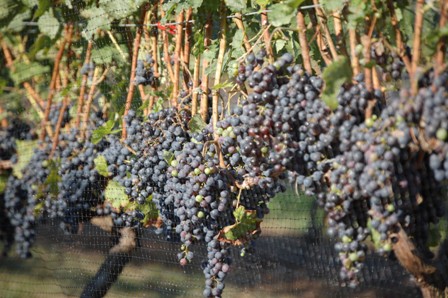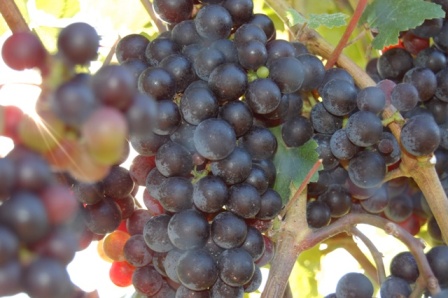|
Syrah or Shiraz You Cannot Go WrongSyrah or Shiraz is a dark-skinned grape grown throughout the world and used primarily to produce powerful red wines. These red wines enjoy great popularity. This red wine is used as a varietal and is also blended. Following several years of strong planting, it was estimated in 2004 to be the world's 7th most grown grape at 142,600 hectares (352,000 acres). DNA profiling in 1999 found this red wine to be the offspring of two obscure grapes from southeastern France, Dureza and Mondeuse Blanche. It should not be confused with Petite Sirah, a synonym for Durif, a cross of Syrah with Peloursin dating from 1880.
Syrah has a long documented history in the Rhône region of Southeastern France, and it was not known if it had originated in that region. In 1998, a study conducted by Carole Meredith's research group in the Department of Viticulture and Enology at University of California, Davis used DNA typing and extensive grape reference material from the viticultural research station in Montpellier, France to conclude that it was the offspring of the grape varieties Dureza (father) and Mondeuse Blanche (mother). Dureza is a dark-skinned grape variety from the Ardèche region in France that has all but disappeared from the vineyards, and the preservation of such varieties is a speciality of Montpellier. Mondeuse Blanche is a white grape variety cultivated in the Savoy region, and is still found in very small amounts in that region's vineyards today. Both varieties are somewhat obscure today and have never achieved anything near Syrah's fame or popularity, and there is no record of them ever having been cultivated at long distances from their present home. Thus, both Syrah's parents come from a limited area in southeastern France, very close to northern Rhône. Based on these findings, the researchers have concluded that Syrah originated from northern Rhône. The DNA typing leaves no room for doubt in this matter, and the numerous other hypotheses of the grape's origin which have been forwarded during the years all completely lack support in form of documentary evidence or ampelographic investigations, be it by methods of classical botany or DNA. Instead, they seem to have been based primarily or solely on the name or synonyms of the variety. Because of varying orthography for grape names, especially for old varieties, this is in general very thin evidence. Despite this, origins such as Syracuse or the Iranian city of Shiraz have been proposed. The parentage information does however not reveal how old the grape variety is, i.e., when the pollination of a Mondeuse Blanche vine by Dureza took place, leading to the original Syrah seed plant. In the year AD 77, Pliny the Elder wrote in his Naturalis Historia about the wines of Vienne (which today would be called Côte-Rôtie), where the Allobroges made famous and prized wine from a dark-skinned grape variety that had not existed some 50 years earlier, in Virgil's age. Pliny called the vines of this wine Allobrogica, and it has been speculated that it could be today's Syrah. However, the description of the wine would also fit, for example, Dureza and Pliny's observation that the vines of this red wine.
The name Shiraz became popular for this grape variety in Australia, where it has long been established as the most grown dark-skinned variety. In Australia it was also commonly called Hermitage up to the late 1980s, but since that name is also a French Protected designation of origin, this naming practice caused a problem in some export markets and was dropped. The name Shiraz for this grape variety is also commonly used in South Africa and Canada. The grape is also known under many other synonyms that are used in various parts of the world including Antourenein Noir, Balsamina, Candive, Entournerein, Hignin Noir, Marsanne Noir, Schiras, Sirac, Syra, Syrac, Serine, and Sereine. Legends of this red wine's origins come from one of its synonyms - Shiraz. Because a city in Iran called Shiraz produced the well-known Shirazi wine, legends claim that the Syrah grape originated in Shiraz and then was brought to Rhône. This association suggests that "Syrah" is a local French synonym and "Shiraz" is the proper name. There are at least two significantly different versions of the myth, giving different accounts of how the variety is supposed to have been brought from Shiraz to Rhône and differing up to 1,800 years in dating this event. In one version, the Phocaeans should have brought Syrah/Shiraz to their colony around Marseilles (then known as Massilia), which was founded around 600 BC. The grape should then later have made its way to northern Rhône, which was never colonized by the Phocaeans. No documentary evidence exists to back up this legend, and it also requires that the variety later has vanished from the Marseilles region without leaving any trace. In another version, the person who brought the variety to Rhône is even named, being the crusader Gaspard de Stérimberg, who is supposed to have built the chapel at Hermitage. Even before the advent of DNA typing of grapes, there were several problems with this legend. First, no ampelographic investigations of the grapes from Shiraz seem to have been made. Second, it is documented that the famous Shirazi wine was white, ruling out the use of dark-skinned grapes such as this red wine, and no known descriptions of this wine's taste and character indicate any similarity whatsoever with red wines from the Rhône. Third, it is highly doubtful if any crusader would have journeyed as far east as Persia, since the crusades were focused on the Holy Land. Since the name Shiraz has been used primarily in Australia in modern time, while the earliest Australian documents use the spelling "Scyras", it has been speculated that the name Shiraz is in fact a so-called "strinization" of Syrah's name via Scyras. However, while the names Shiraz and Hermitage gradually seem to have replaced Scyras in Australia from the mid-19th century, the spelling Shiraz has also been documented in British sources back to at least the 1830s. So, while the name or spelling Shiraz may be an effect of the English language on a French name, there is no evidence that it actually originated in Australia, although it was definitely the Australian usage and the Australian wines that made the use of this name popular.
Wines made from Syrah are often powerfully flavoured and full-bodied. The variety produces wines with a wide range of flavor notes, depending on the climate and soils where it is grown, as well as other viticultural practices chosen. Aroma characters can range from violets to berries (usually dark as opposed to red), chocolate, espresso and black pepper. No one aroma can be called "typical" though blackberry and pepper are often noticed. With time in the bottle these "primary" notes are moderated and then supplemented with earthy or savory "tertiary" notes such as leather and truffle. "Secondary" flavor and aroma notes are those associated with several things, generally winemakers' practices
|
Sign up for weekly Red Wine Reviews
CLICK HEREWe will send you the extremely popular Red-Wine-Home tasting terms when you sign-up.






